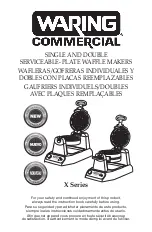
19
Cleaning parts
Remove bits of dough on the union nut
5
and on the threads using the cleaning
brush
3
.
Clean the mixing container
10
and pressing collar
8
with a moist cloth and house-
hold washing-up liquid.
Clean all other parts that come into contact with dough with hot water and a
household washing-up liquid or in a dishwasher.
Assemble mixing shaft and pressing shaft
Push the pressing shaft
2
through the pressing collar
8
into the receptacle of the
pressing shaft
11
.
Insert the box mould
6
onto the pressing collar
8
.
Screw the union nut
5
onto the pressing collar
8
and tighten the union nut
5
slightly.
Place the mixing shaft
1
into the receptacle
12
in the mixing container and fasten
the mixing shaft
1
with the counterbearing
9
.
Close the protective cover
13
.
Cleaning the pasta moulds
i
You can find information on storing the pasta moulds in section 6 on page 15.
i
You can either clean and dry used pasta moulds or store them for later use without
a thorough cleaning.
Thoroughly cleaning pasta moulds
CAUTION
Material damage by sharp objects
Sharp objects can damage the Teflon inserts of the pasta moulds.
Do not clean pasta moulds with sharp and pointed objects.
i
Pasta moulds are not dishwasher-safe.
Place the used pasta moulds in water so that the dough loosens.
Clean the pasta mould with clear running water.
If you want to completely remove the remaining bits of dough, clean the pasta
moulds with a steam jet, high-pressure washer or compressor (maximum 7 bar).
Then clean the moulds with water and household washing-up liquid.
Cleaning
















































